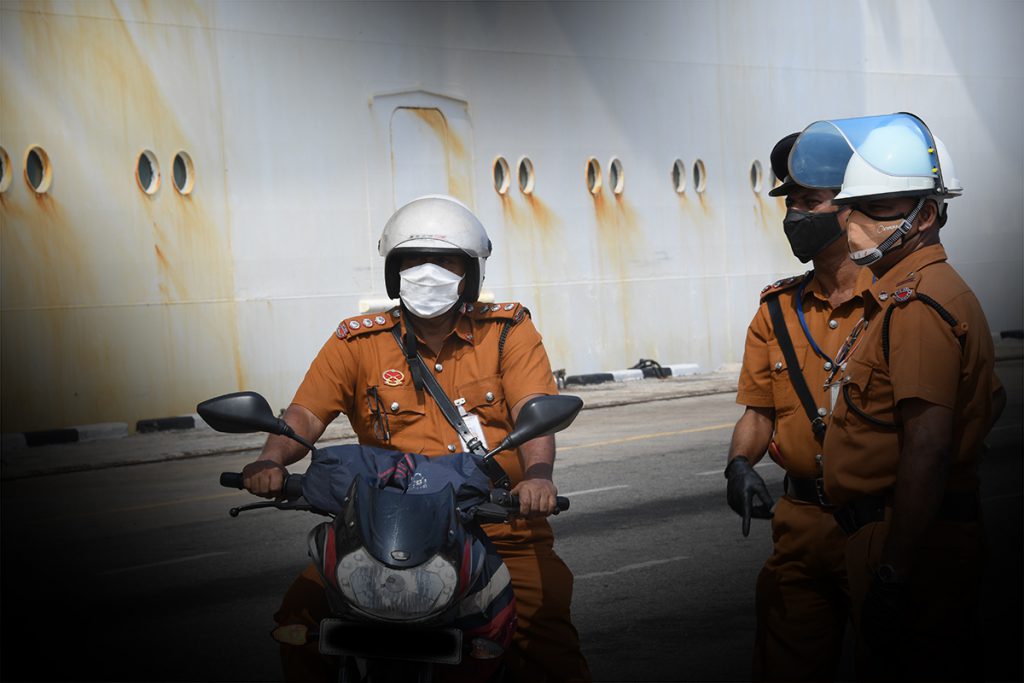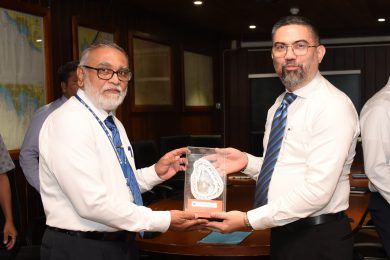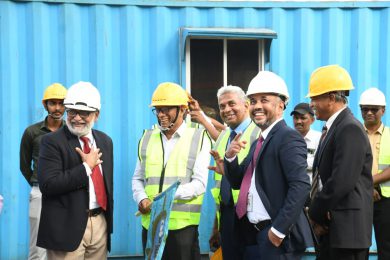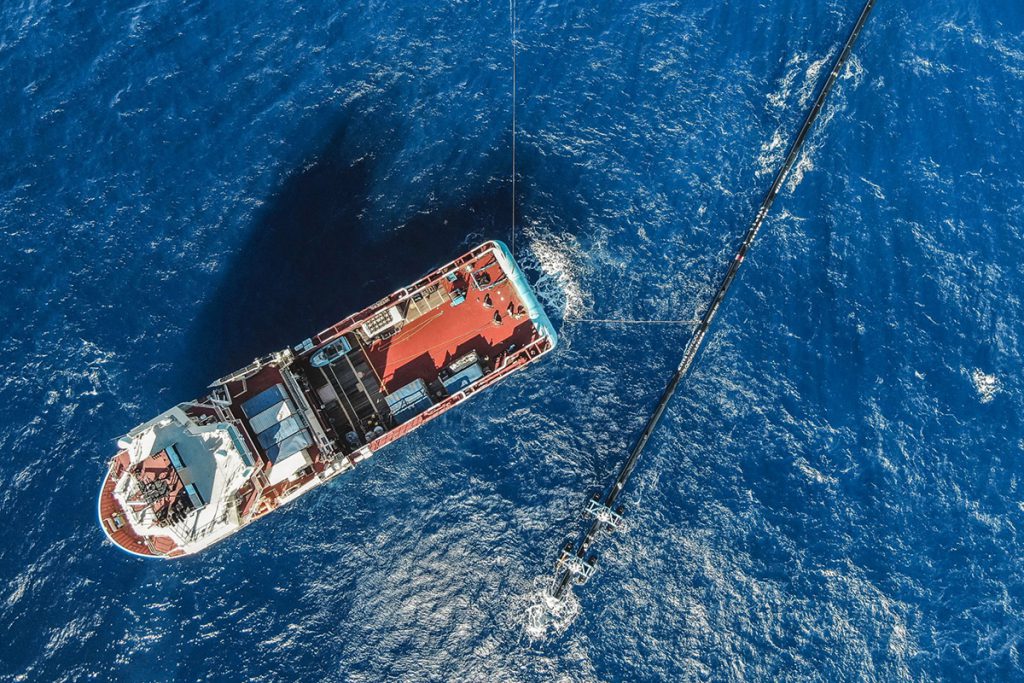“Transforming the Comparative Advantage to a Competitive Advantage”
General Daya Ratnayake’s Goal for Sri Lanka’s Maritime Industry
The following interview with Gen. Daya Ratnayake, Chairman, Sri Lanka Ports Authority, was originally published in the latest issue of the Bridge, a regular publication of the Ceylon Association of Shipping Agents ( CSA), republished with the permission of the publisher.
by Rochelle Palpate Guarantee
Leveraging his experience of strategizing battle plans during the civil war and following its protocols for the safety of the countrymen, Gen. Daya Ratnayake led the personnel at the ports authority in a war against an unseen enemy; the deadly COVID-19 virus. During his brief tenure since taking on the reigns as the Chairman of SLPA, he has proven his ability as a courageous leader and a visionary at the helm of the nation’s economic heartbeat; the Sri Lanka Port.

Question: How did SLPA manage to continue port operations during the pandemic? What were the challenges and how did you overcome them?
Answer: “First and foremost we had to understand the problem in order to solve it. Thereafter, we had to take action even at the preliminary stages as the Port is the gateway to any country with goods being received from every part of the world. It is a highly centralized area in which international, regional and domestic interactions are manifest. Hence, quarantine is not something new in the operational jargon of the Port with representatives from the Health Ministry inspecting every ship upon arrival for virulent or contagious cargo or crew. This was the norm prior to the safety measures implemented due to the pandemic, which prompted us to act swiftly long before the virus reached a pandemic stage.
With regard to the COVID 19 – prompt initiatives, as early as January 2020, were taken by H.E. President Gotabhaya Rajapakse, who formed a task force of which I too was part of in order to battle the unseen enemy. Thereby I obtained first-hand knowledge of the situation and the countermeasures to be taken. Initially, we invited two of the Health Ministry Doctors to share their knowledge and sent the Doctors on the ground to obtain sufficient information, followed the guidelines given by the Presidential Secretariat and educated our staff. Subsequently, these regulations were documented and published as a safety manual.
The other area of concern was the passenger cruise lines berthing at the Port, which averaged approximately 55 ships per year with about 1,000 passengers each on board. Thereby immediate action had to be taken to minimize the face-to-face interactions, which gave us ample opportunity to expedite the e-platforms which were in the pipeline for more than two years.
Prior to the issuance of the government directives, we decided to reduce the staff from an average 10,000 to 2,500, handling only the essential services and working on rotation basis at any given time as the Port had to operate around the clock. This significant step did not cause any delays as efficiency was at one hundred percent. The key to our success was identifying the problem at the initial stages, formulating a strategic plan, educating the employees, implementing and monitoring which included random testing done cross-section-wise. We also had the unstinted support and cooperation of our employees in all divisions and the Navy personnel at the Port.
Q: What are the best practices that were implemented during the pandemic which can continue in the future?
A: The ability to conduct efficient operations with a smaller number (one third of the total number of employees) of staff during lockdown is an incentive to continue in this manner, which in turn motivates employees to perform well.
There were bouts of trial and error but we learned our lessons well and maximized on the opportunities. For instance the E-platforms pertaining to delivery orders, management systems, issuance of gate passes and more were given prominence and continues at present as it has eliminated delays and resulted in a paperless form of communication and storage with all stake holders from banks to shipping lines , customs, clients and others working together to ensure an efficient and seamless operation.
Q: We learn that the cranes which were bought for JCT Phase5 expansion will be installed at ECT. Are those cranes appropriate for a deepwater terminal such as ECT?
A: Primarily, the building of ECT was planned in 2013/2014 and 40% of it was completed in the beginning of 2015 but the change of government brought its progress to a grinding halt with the cancellations of the order for four cranes and 12 RTGs. If the situation was reversed and the ECT which costs USD286 million to build was in operation, the country would have incurred millions as the four cranes could have handled 800,000 containers per year. Further, the previous regime had signed Memorandums of Cooperation with India and Japan to operate ECT and ordered three cranes for a terminal which was still in its planning stages called JCT 5, which despite the tender being handed to a company, is yet to be built.
Operationalizing ECT was tantamount to the industry and the decision was made to utilize the cranes which were on its way to port despite the mismatch as a further delay in operation would incur a loss. We were also faced with a dilemma as the MOC signed with India and Japan by the previous regime is immovable and authorizes the Indian Government to manage the ECT which was disheartening to our local staff who had eagerly anticipated the task. Therefore we will be unloading the cranes, testing and commissioning it in due course.
Q: How does the milestone achievement of over 7 million TEUs in the Port of Colombo raise the bar for SLPA in 2020?
A: Since 8.0 million TEU’s is the capacity in the current terminals and we have almost achieved it, the next step is to improvise terminals such as ECT and develop other terminals which are in the pipeline.
Q: What are your views on the SL port being positioned as the 13th best connectivity port in the world and the best connectivity port in South Asia? How can we improve in terms of world rankings?
A: There is a great need for improvement in all areas; the development of capacity through ECT with its 18m deep draft will increase the capacity by 2.5 million while an additional terminal identified as West Container Terminal (WCT) will boost the capacity by 2.5-3 million with a deep draft of 20-22m. At present CICT can accommodate the biggest ships in the world which is an advantage. There are plans to equip the new terminals with the modern ultra-large cranes and other state-of-theart facilities and infrastructure along with the improvement of technology and the Port Community System which will be instrumental in integrating all stakeholders and creating a one-stop mechanism for ease-of-business. Being on par with international standards and reaching a higher world ranking also requires the improvement in the quality of HR, creating an environment conducive to standards, while eliminating old or obsolete facilities is crucial. Another niche area is the growth of value added services, LCL and MCC business along with the integration of the railway and other modes of delivery in our goal to reach the highest ranking.
Q: For Sri Lanka to retain its competitiveness as a Trans-Shipment hub and with the lines upsizing their fleets, capacity needs to be added at a brisk pace. What plans does the SLPA have to increase capacity in Colombo and what are the timelines?
A: Commencement of the operation of ECT with immediate effect and continuity in balancing the work in stages and the completion of the ECT by 2025. Further, the development of WCT is also planned in parallel with ECT, with the commencement of operations beginning in the first stage in 2023 and completed by 2024.
Additionally, the capacity increase through ECT, WCT, the development of Trincomalee, KKS and Hambanthota are taking place in stages and despite the delay due to the lockdown which prolonged progress, it will take about 1 ½ years to complete.
Q: SLPA signed a deal to conduct a feasibility study for Colombo North Port with AECOM Infrastructure & Environment UK Limited. Can you tell us the timelines for completion of this feasibility study?
A: The UK firm was selected following the issuance of an Expression of Interest and subsequent request for proposal. The SLPA used a portion of the ADB funded Transport Project Preparatory Facility for the feasibility study and the duration of the study is expected to be fifteen months.
Q: Do you have any plans for a purpose-built facility for conventional cargo in the North Port plan?
A: In the Feasibility study for the North port Project, a deep draft terminal facility for conventional cargo operation will be considered including the facilities for dry bulk, liquid and gas. The North Port Development plan includes Logistics Centers in addition to other purpose-built facilities. The obsolete areas are used for capacity building along with the development of a facility in the twenty- five-acre land in Bloemendhal. All the plans pertaining to these projects are underway and the implementation is scheduled to commence phase by phase on-demand in the following months.
Q: Being the second largest natural harbour in the world, the Trincomalee Port is often overlooked. What plans do you have to develop this port?
A: We have appointed a dedicated team to optimize the best measures in terms of development for the Trincomalee Port which has been an area of neglect for too long.

Q: There is a rapid increase in the number of passenger ships arriving at the Port of Colombo. So, it is clear that the Port of Colombo is becoming a favorite tourist destination. Do you have any plans in developing the passenger terminal for cruise ships?
A: Prior to the lockdown, an average fifty five cruise ships were being berthed per year at the Port of Colombo which is a significant number, prompting us to identify the untapped potential. After speaking to operators and the Tourist Board, plans are underway to develop a new passenger cruise terminal within a period of two to three years.
Q: How has technology and automation boosted the standing of SLPA?
A: Corona was a blessing in disguise as it boosted the online platforms, enabling 30% -35% of SLPA’s standing. It also prompted us to obtain the services of consultants who are developing the a synchronized port community system which will take 1 ½ to two years. It is a master plan which is being executed stage by stage in order to reach international standards.
Q: India has been heavily investing in ports. Will this be a threat to Colombo as these ports may attract more ships there and divert TS traffic away from Colombo?
A: The President and government are eager to transform Sri Lanka’s comparative geographical advantage to a competitive advantage through a series of comprehensive strategies to develop and improve all aspects. Within a brief duration of seven months, we have seen the colossal steps taken to achieve this goal through a plethora of multi-faceted schemes from the operationalizing of ECT to the planning and development of WCT, passenger terminal, three value-added logistics facilities for MCC and LCL business and an infra -logistics hub. The wheels are in motion for the completion of our maritime vision for the country through the further development of the Trincomalee Port, transformation of the Galle Port into a tourist hub through the implementation of an USD 200million project to develop a new breakwater which will increase the growth and trajectory of the Galle Port from 35 hectares to a staggering 300 hectares, transforming the southern landscape.
We are also on the verge of signing a USD 42million agreement with the support of the Indian Government to extend the length of the break-water and the port system in KKS as plans are finalized and companies shortlisted for the implementation of the project. In addition, the Hambantota Port will enhance operations in due course, which ensures an overall drive towards achieving the competitive advantage as a strong maritime force in the region.
Q: With various Terminal Operators managing the private Terminals as well as CM Port Holdings managing Hambantota, should there be an Independent Port regulator, as the role of SLPA as an operator and regulator could be a conflict of interest? What are your views?
A: As a country, Sri Lanka has a huge capacity and in the maritime sphere the companies and government institutions work towards a common goal in a unified effort with an iota of competition which I perceive as being healthy.
Q: Has China Merchant Port Holdings (CMPH) been able to attract any new business to Hambantota port since signing the concession agreement with the SL Government?
A: Hambantotha Port will commence its operations after the installation of the operational equipment within a period of one to two years.
Q: Is there any progress in the marine yacht facility at the Galle port?
A: The plans are in being finalized while companies are being shortlisted for the development project which will transform Galle Port to a yacht marina with the ability to berth more yachts.
Q: What role do you expect the logistics and shipping industry to play in order to achieve the objective of maritime hub status?
A: Improving every facet connected to the maritime industry is imperative to achieving maritime hub status; from enhancing the quality of life of our workers to infrastructure development, capacity building, introducing new policies and government laws and more. The industry has a wealth of human resources with world-class capabilities from the basic worker to the top class engineer and we need to harness the talent in order to reach the potential. A team involving all stakeholders is crucial to planning and transforming these thoughts into action.
Q: Conventional cargo – does it have a significant place in your plan of things for the Port of Colombo?
A: Conventional cargo is viewed as a declining business but we are currently continuing it at UCT. ECT too will be used for it while we have plans to transfer fertilizer and cement to Trincomalee.
Q: How has your experience as an avid sportsman and a military personal contributed towards managing your new role?
A: A soldier thrives amid volatility, complexity and ambiguity and that first tenure of my new role was filled with unprecedented challenges due to the pandemic but my experience in the competitive field of sports and the volatility of the battlefield gave me the ability to look at the present situation and strategize on how best to overcome the challenge and reach the goal…























